Risk Assessment Method Combining Independent Protection Layers (IPL) of Layer of Protection Analysis (LOPA) and RISKCURVES Software: Case Study of Hydrogen Refueling Stations in Urban Areas
Abstract
:1. Introduction
2. Materials and Methods
2.1. Risk Assessment Using RISKCURVES
2.2. Active/Passive Individual Protection Layers
3. Results and Discussion
3.1. Risk Assessment without IPLs
3.2. Risk Assessment with Passive IPLs
3.3. Risk Assessment with Active IPLs
4. Conclusions
Supplementary Materials
Author Contributions
Funding
Institutional Review Board Statement
Informed Consent Statement
Data Availability Statement
Conflicts of Interest
Abbreviation
| Abbreviation | Meaning |
| LOPA | Layer of Protection Analysis |
| QRA | Quantitative Risk Assessment |
| FTA | Fault Tree Analysis |
| HAZOP | Hazard and Operability Analysis |
| FMEA | Failure Mode Effect Analysis |
| GRA | Generic Risk Analysis |
| CCPS | Center for Chemical Process Safety |
| IPLs | Independent Protection Layers |
| ALARP | As low As Reasonably Practicable |
| IR | Individual Risk |
| SR | Societal Risk |
| F–N curve | Frequency–Number of Fatalities Curve |
| RMP | Risk Management Program |
| EPA | Environmental Protection Agency |
| PFD | Probability of Failure on Demand |
| IEC | International Electrotechnical Commission |
| CFD | Computation Fluid Dynamics |
References
- Zhang, B.; Wu, Y. Recent advances in improving performances of the lightweight complex hydrides Li-MgN-H system. Prog. Nat. Sci. Mater. Int. 2017, 27, 21–33. [Google Scholar] [CrossRef]
- Deveci, M. Site selection for hydrogen underground storage using interval type-2 hesitant fuzzy sets. Int. J. Hydrog. Energy 2018, 43, 9353–9368. [Google Scholar] [CrossRef]
- Abe, J.O.; Popoola, A.P.I.; Ajenifuja, E.; Popoola, O.M. Hydrogen energy, economy and storage: Review and recommendation. Int. J. Hydrog. Energy 2019, 44, 15072–15086. [Google Scholar] [CrossRef]
- Sahaym, U.; Norton, M.G. Advances in the application of nanotechnology in enabling a ‘hydrogen economy’. J. Mater. Sci. 2008, 43, 5395–5429. [Google Scholar] [CrossRef] [Green Version]
- Jovan, D.J.; Dolanc, G. Can green hydrogen production be economically viable under current market conditions. Energies 2020, 13, 6599. [Google Scholar] [CrossRef]
- Staffell, I.; Scamman, D.; Abad, A.V.; Balcombe, P.; Dodds, P.E.; Ekins, P.; Shah, N.; Ward, K.R. The role of hydrogen and fuel cells in the global energy system. Energy Environ. Sci. 2019, 12, 463–491. [Google Scholar] [CrossRef] [Green Version]
- De Miranda, P.E. Science and Engineering of Hydrogen-Based Energy Technologies, 1st ed.; Academic Press: New York, NY, USA, 2018; pp. 33–45. [Google Scholar]
- Liu, Y.; Liu, Z.; Wei, J.; Lan, Y.; Yang, S.; Jin, T. Evaluation and prediction of the safe distance in liquid hydrogen spill accident. Process Saf. Environ. Prot. 2021, 146, 1–8. [Google Scholar] [CrossRef]
- Hansen, O.R. Hydrogen infrastructure- Efficient risk assessment and design optimization approach to ensure safe and practical solutions. Process Saf. Environ. Prot. 2020, 143, 164–176. [Google Scholar] [CrossRef]
- Crowl, D.A.; Jo, Y.D. The hazards and risks of hydrogen. J. Loss Prev. Process Ind. 2007, 20, 158–164. [Google Scholar] [CrossRef]
- Pan, X.; Yan, W.; Jiang, Y.; Wang, Z.; Hua, M.; Wang, Q.; Jiang, J. Experimental investigation of the self-ignition and jet flame of hydrogen jets released under different conditions. ACS Omega 2019, 4, 12004–12011. [Google Scholar] [CrossRef] [Green Version]
- Alternative Fueling Station Counted by State. Available online: https://afdc.energy.gov/stations/states (accessed on 14 June 2021).
- Hydrogen Mobility Europe. Available online: https://h2me.eu/about/ (accessed on 13 June 2021).
- Chaybe, A.; Chapman, A.; Shigetomi, Y.; Huff, K.; Stubbins, J. The role of hydrogen in archiving long term Japanese energy system goals. Energies 2020, 13, 4539. [Google Scholar] [CrossRef]
- Jaworski, J.; Kulaga, P.; Blacharski, T. Study of the effect of addition of hydrogen to natural gas on diaphragm gas meters. Energies 2020, 13, 3006. [Google Scholar] [CrossRef]
- Matsuoka, S.; Yamabe, J.; Matsunaga, H. Criteria for determing hydrogen compatibility and the mechanism for hydrogen-assisted, surface crack growth in austenitic stainless steels. Eng. Fract. Mech. 2016, 153, 103–127. [Google Scholar] [CrossRef]
- Wessiani, N.A.; Yoshio, F.Y. Failure mode effect analysis and fault tress analysis as a combined methodology in risk management. In IOP Conference Series: Materials Science and Engineering; IOP Publishing: Bristol, UK, 2018; Volume 337, p. 012033. [Google Scholar]
- Fuentes-Bargues, J.L.; González-Cruz, M.C.; González-Gaya, C.G.; Baixauli-Pérez, M.P. Risk analysis of a fuel storage terminal using HAZOP and FTA. Int. J. Environ. Res. Public Health 2017, 14, 705. [Google Scholar] [CrossRef]
- Chief Fire & Rescue Adviser. Fire and Rescue Service Operation Guidance: GRAs Generic Risk Assessments, 1st ed.; TSO (The Stationery Office): Norwich, UK, 2009; pp. 1–26. [Google Scholar]
- Suzuki, T.; Shiota, K.; Izato, Y.; Komori, M.; Sato, K.; Takai, Y.; Ninomiya, T.; Miyake, A. Quantitative risk assessment using a Japanese hydrogen refueling station model. Int. J. Hydrogen Energy 2021, 46, 8329–8343. [Google Scholar] [CrossRef]
- Hansen, O.R.; Middha, P. CFD-based risk assessment for hydrogen applications. Process Saf. Prog. 2008, 27, 29–34. [Google Scholar] [CrossRef]
- Russo, P.; De Marco, A.; Parisi, F. Assessment of the damage from hydrogen pipeline explosions on people and buildings. Energies 2020, 13, 5051. [Google Scholar] [CrossRef]
- Overview of Software. Available online: https://link.springer.com/content/pdf/bbm%3A978-1-84628-717-6%2F1.pdf (accessed on 28 March 2021).
- Groth, K.M.; Hecht, E.S. HYRAM: A methodology and toolkit for quantitative risk assessment of hydrogen systems. Int. J. Hydrogen Energy 2017, 42, 7485–7493. [Google Scholar] [CrossRef] [Green Version]
- Jallais, S.; Vyazmina, E.; Miller, D.; Thomas, J.K. Hydrogen jet vapor cloud explosion: A model for predicting blast size and application to risk assessment. Process Saf. Prog. 2018, 37, 397–410. [Google Scholar] [CrossRef]
- Nakayama, J.; Misono, H.; Sakamoto, J.; Kasai, N.; Shibutani, T.; Miyake, A. Simulation-based safety investigation of a hydrogen fueling station with an on-site hydrogen production system involving methylcyclohexane. Int. J. Hydrog. Energy 2017, 42, 10636–10644. [Google Scholar] [CrossRef]
- Introduction to Consequence Modelling. Available online: https://www.dnv.com/Images/Introduction%20to%20Consequence%20Modelling%20Webinar%20-%20QaA_tcm8-86021.pdf (accessed on 28 March 2021).
- Sakamoto, J.; Misono, H.; Nakayama, J.; Kasai, N.; Shibutani, T.; Miyake, A. Evaluation of safety measures of a hydrogen fueling station using physical modeling. Sustainability 2018, 10, 3846. [Google Scholar] [CrossRef] [Green Version]
- Crowl, D.A.; Louvar, J.F. Chemical Process Safety Fundamentals with Applications, 4th ed.; Pearson Inc.: Boston, MA, USA, 2019; pp. 515–525. [Google Scholar]
- Pasman, H.J.; Rogers, W.J. Risk assessment by men as of Bayesian networks: A comparative study of compressed and liquefied H2 transportation and tank station risks. Int. J. Hydrog. Energy 2012, 37, 17415–17425. [Google Scholar] [CrossRef]
- H2STATION Hydrogen Safety Plan. Available online: https://h2tools.org/sites/default/files/App2_Consolidated_Safety_Plans.pdf (accessed on 29 March 2021).
- GEXCON, RISKCURVES: Comprehensive Quantitative Risk Analysis. Available online: https://www.gexcon.com/wp-content/uploads/2020/04/Gexcon2019_Datacards_Product_RISKCURVES_11.11.20.pdf (accessed on 14 June 2021).
- Tzenova, Z. Calculation of individual risk and social risk in accident situations in industrial production. In AIP Conference Proceedings; AIP Publishing LLC: Melville, NY, USA, 2018; Volume 2048, p. 020012. [Google Scholar]
- Bommer, J.J.; Crowley, H.; Pinho, R. A risk-mitigation approach to the management of induced seismicity. J. Seismol. 2015, 19, 623–646. [Google Scholar] [CrossRef] [PubMed] [Green Version]
- Sun, M.; Zheng, Z.; Gang, L. Uncertainty analysis of estimated risk in formal safety assessment. Sustainability 2018, 10, 321. [Google Scholar] [CrossRef] [Green Version]
- Sandia National Laboratories. Analyses to Support Development of Risk-Informed Separation Distances for Hydrogen Codes and Standards. Available online: https://energy.sandia.gov/wp-content/uploads/2018/05/SAND2009-0874-Analyses-to-Support-Development-of-Risk-Informed-Separation-Distances-for-Hydrogen-Codes-and-Standards.pdf (accessed on 20 June 2021).
- Crowl, D.A. Simplified Process Risk Assessment: Layer of Protection Analysis, 1st ed.; American Institute of Chemical Engineers: New York, NY, USA, 2001; pp. 50–134. [Google Scholar]
- International Electrotechnical Commission. IEC 61508; Functional Safety of Electrical/Electronic/Programmable Electronic Safety-Related Systems, Parts 1~7; International Electrotechnical Commission: Geneva, Switzerland, 1998. [Google Scholar]
- International Electrotechnical Commission. IEC 61511; Functional Safety Instrumented System for the Process Industry Sector, Parts 1~3; International Electrotechnical Commission: Geneva, Switzerland, 2004. [Google Scholar]
- Mair, G.W.; Thomas, S.; Schalau, B.; Wang, B. Safety criteria for the transport of hydrogen in permanently mounted composite pressure vessels. Int. J. Hydrog. Energy 2021, 46, 12577–12593. [Google Scholar] [CrossRef]

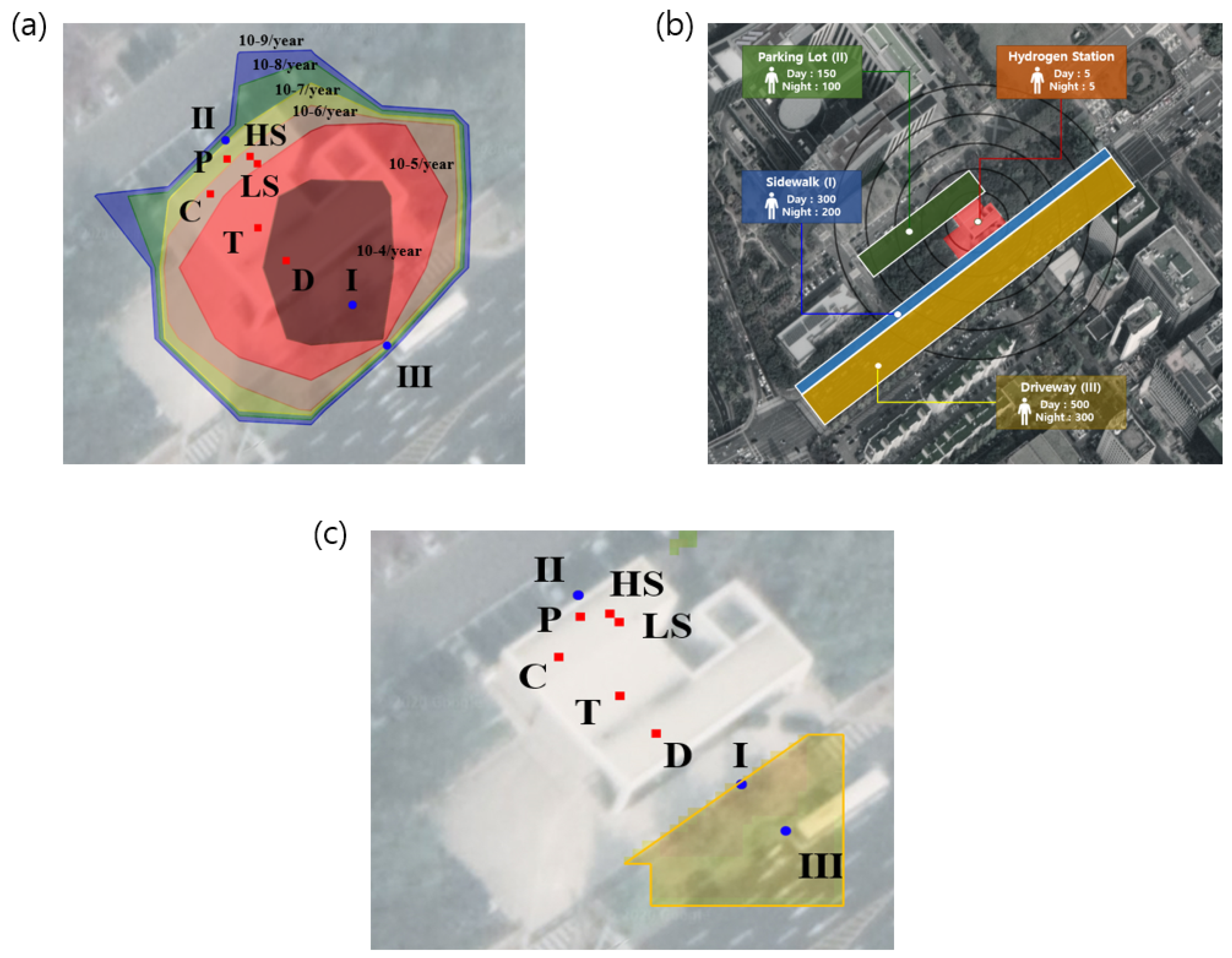

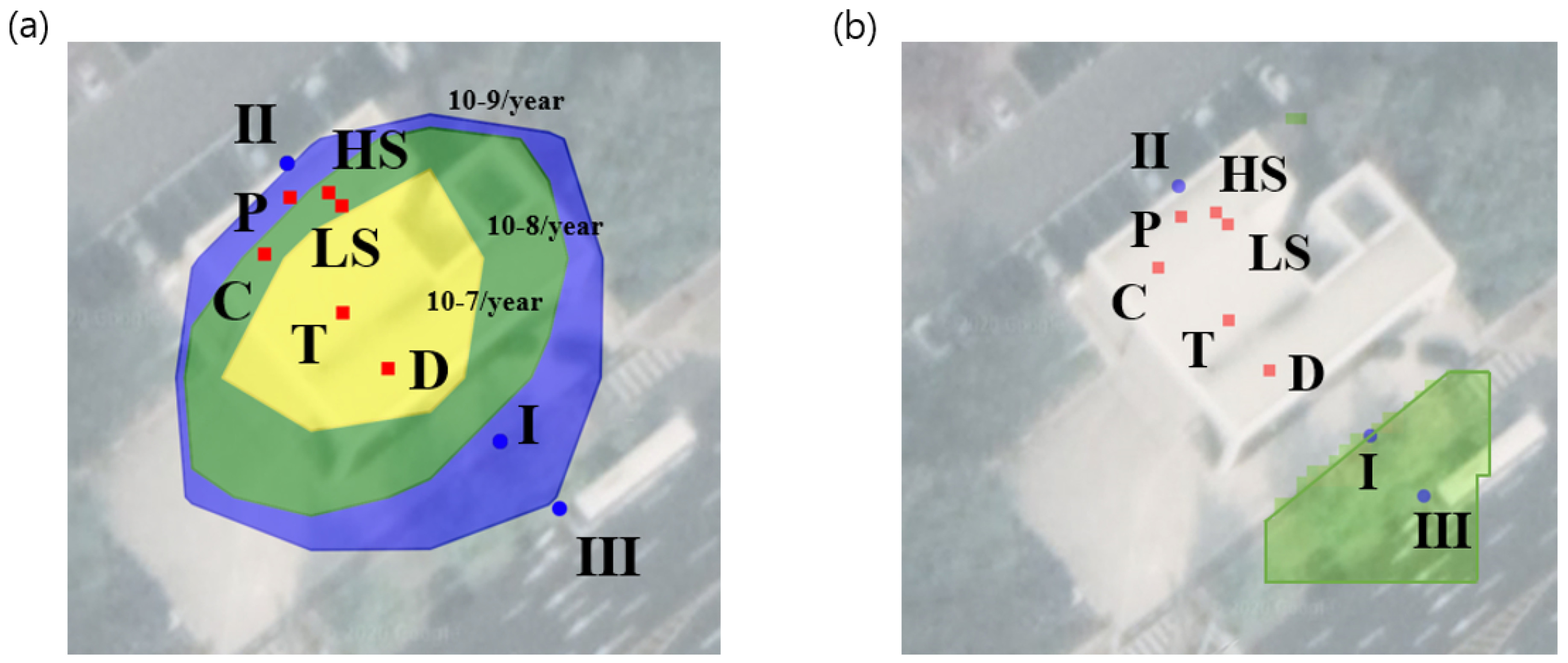
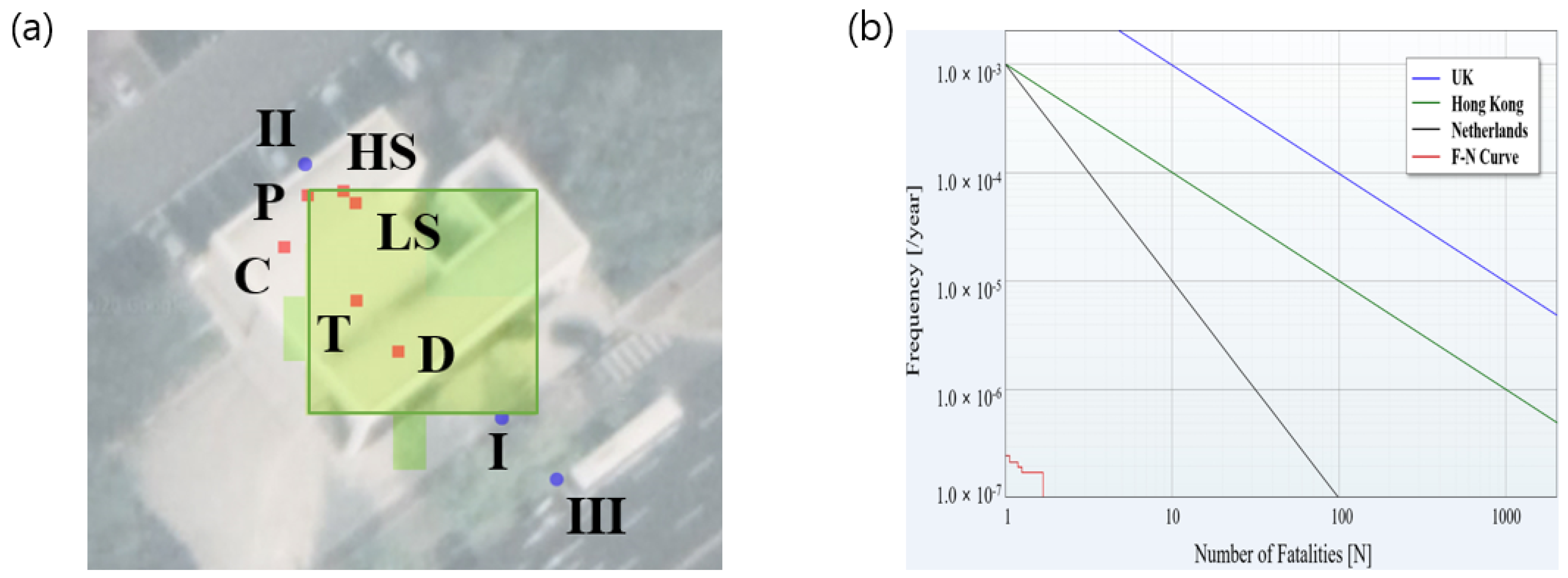
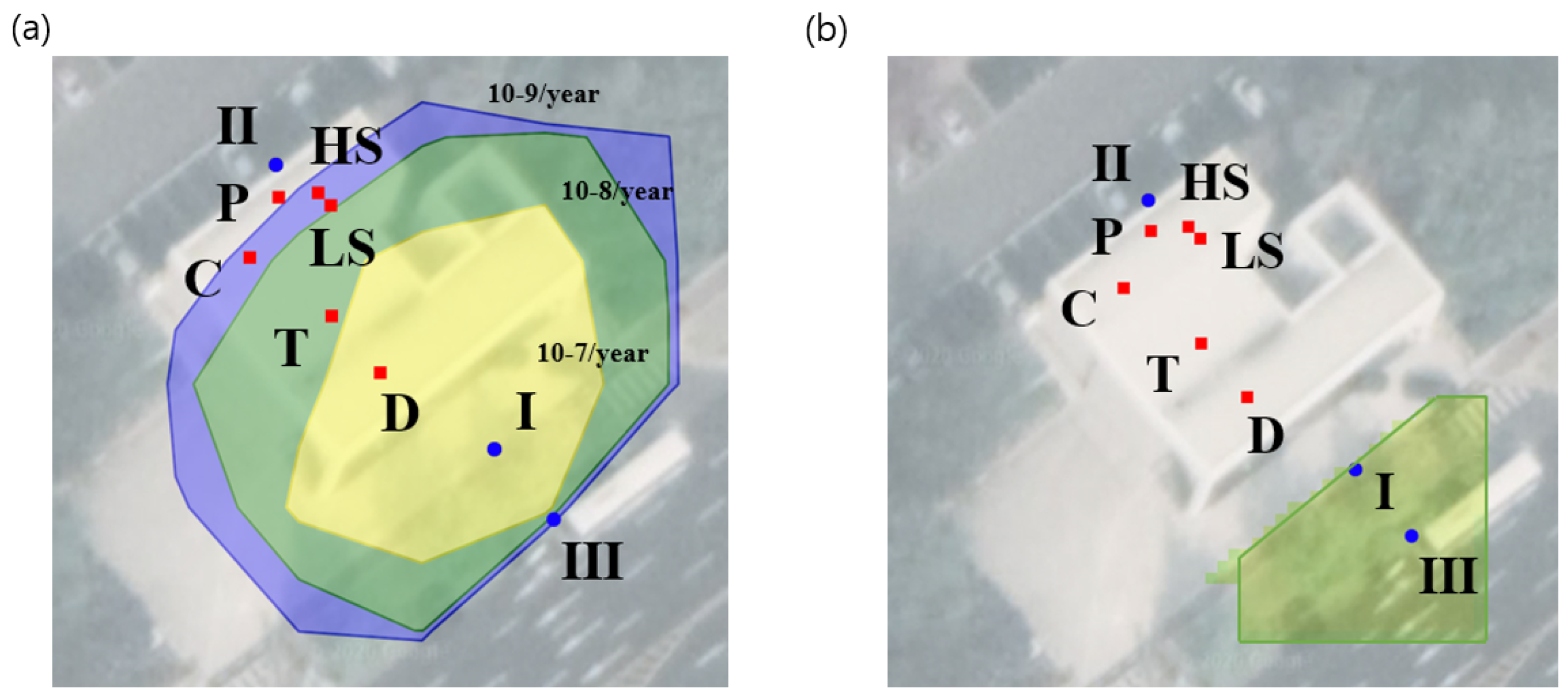
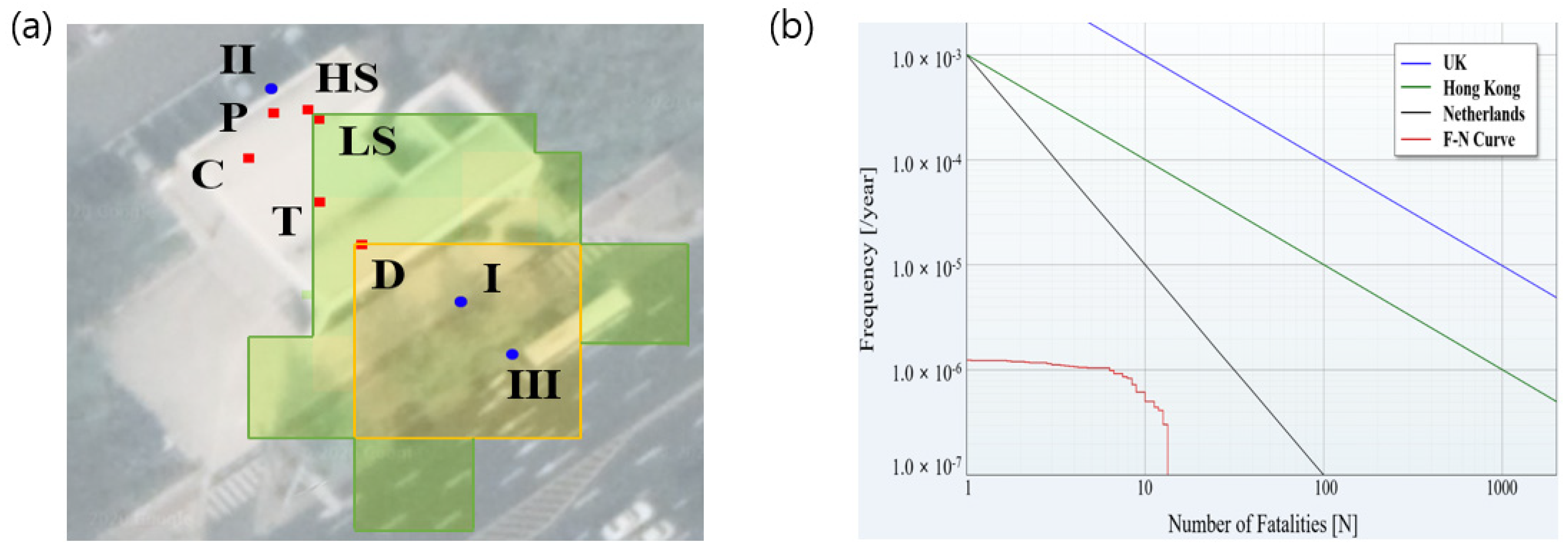
| Sidewalk (I) | Parking Lot (II) | Driveway (III) | |
|---|---|---|---|
| Number of people (day) | 300 | 150 | 500 |
| Number of people (night) | 200 | 100 | 300 |
| Parameters | Average Temperature | Humidity | Wind Speed | Wind Direction | Atmospheric Pressure | Accident Type |
|---|---|---|---|---|---|---|
| Value | 13.3 ˚C | 63.3% | 2.37 m/s | NW | 1 atm | Jet flame |
| No. | Components | Pressure (MPa) | Scenario (Leak) | Leak Size (mm) | Leak Rate (kg/s) | Leak Frequency (/year) |
|---|---|---|---|---|---|---|
| 1 | Tube trailer | 20 | Small | 0.40 | 1.30 × 10−3 | 1.07 × 10−3 |
| Medium | 4.02 | 1.31 × 10−1 | 3.21 × 10−4 | |||
| Large | 12.70 | 1.31 × 100 | 1.80 × 10−4 | |||
| 2 | H2 storage (HP) | 82 | Small | 0.23 | 1.76 × 10−3 | 3.47 × 10−3 |
| Medium | 2.26 | 1.70 × 10−1 | 2.09 × 10−4 | |||
| Large | 7.16 | 1.71 × 100 | 1.02 × 10−4 | |||
| 3 | H2 storage (LP) | 40 | Small | 0.25 | 1.02 × 10−3 | 3.47 × 10−3 |
| Medium | 2.50 | 1.02 × 10−1 | 2.09 × 10−4 | |||
| Large | 7.92 | 1.02 × 100 | 1.02 × 10−4 | |||
| 4 | Dispenser | 70 | Small | 0.23 | 1.50 × 10−3 | 7.06 × 10−4 |
| Medium | 2.26 | 1.45 × 10−1 | 1.85 × 10−4 | |||
| Large | 7.16 | 1.46 × 100 | 9.88 × 10−5 | |||
| 5 | Compressor | 82 | Small | 0.23 | 1.76 × 10−3 | 2.76 × 10−3 |
| Medium | 2.26 | 1.70 × 10−1 | 2.62 × 10−5 | |||
| Large | 7.16 | 1.71 × 100 | 4.24 × 10−6 | |||
| 6 | Priority panel | 82 | Small | 0.23 | 1.76 × 10−3 | 1.20 × 10−3 |
| Medium | 2.26 | 1.70 × 10−1 | 8.32 × 10−5 | |||
| Large | 7.16 | 1.71 × 100 | 3.84 × 10−5 |
| No. | Passive IPLs | Contents | PFDs from CCPS |
|---|---|---|---|
| P1 | Dike | Reduces the range of leakage from the hydrogen storage tank | 10−2 |
| P2 | Underground draining system | Reduces the range of leakage of a tank overfill, rapture, spill, etc. | 10−2 |
| P3 | Open vent (no valve) | Prevents overpressure | 10−2 |
| P4 | Fireproofing | Reduces the rate of heat input and provides additional time for firefighting | 10−2 |
| P5 | Blast wall or bunker | Reduces the range of damage from major accidents | 10−3 |
| P6 | Inherently safer design | Reduces accident scenarios through fundamental safety design | 10−2 |
| P7 | Flame or detonation arrestors | Restriction of entry of flame sources into tanks or piping | 10−2 |
| P8 | Others | Passive IPLs other than the above devices |
| No. | Passive IPLs | Contents | PFDs from CCPS |
|---|---|---|---|
| A1 | Gas detector and emergency shutoff valve | Facility to immediately detect and act when hydrogen leaks | 10−1 |
| A2 | Relief valve/rapture disc | Prevents overpressure from being exceeded in hydrogen plants | 10−2 |
| A3 | Basic process control system | Keep the process under control | 10−1 |
| A4 | Others | Active IPLs other than the above devices |
| No. | Components | Safety Device | |
|---|---|---|---|
| Passive | Active | ||
| 1 | Tube trailer | A1, A2 | P1, P3, P4, P6 |
| 2 | H2 storage (HP) | A1, A2 | P1, P3, P4, P6 |
| 3 | H2 storage (LP) | A1, A2 | P1, P3, P4, P6 |
| 4 | Dispenser | A2 | P2, P6 |
| 5 | Compressor | A1, A2 | P6 |
| 6 | Priority panel | A1, A2 | P6 |
Publisher’s Note: MDPI stays neutral with regard to jurisdictional claims in published maps and institutional affiliations. |
© 2021 by the authors. Licensee MDPI, Basel, Switzerland. This article is an open access article distributed under the terms and conditions of the Creative Commons Attribution (CC BY) license (https://creativecommons.org/licenses/by/4.0/).
Share and Cite
Park, B.; Kim, Y.; Lee, K.; Paik, S.; Kang, C. Risk Assessment Method Combining Independent Protection Layers (IPL) of Layer of Protection Analysis (LOPA) and RISKCURVES Software: Case Study of Hydrogen Refueling Stations in Urban Areas. Energies 2021, 14, 4043. https://doi.org/10.3390/en14134043
Park B, Kim Y, Lee K, Paik S, Kang C. Risk Assessment Method Combining Independent Protection Layers (IPL) of Layer of Protection Analysis (LOPA) and RISKCURVES Software: Case Study of Hydrogen Refueling Stations in Urban Areas. Energies. 2021; 14(13):4043. https://doi.org/10.3390/en14134043
Chicago/Turabian StylePark, Byoungjik, Yangkyun Kim, Kwanwoo Lee, Shinwon Paik, and Chankyu Kang. 2021. "Risk Assessment Method Combining Independent Protection Layers (IPL) of Layer of Protection Analysis (LOPA) and RISKCURVES Software: Case Study of Hydrogen Refueling Stations in Urban Areas" Energies 14, no. 13: 4043. https://doi.org/10.3390/en14134043
APA StylePark, B., Kim, Y., Lee, K., Paik, S., & Kang, C. (2021). Risk Assessment Method Combining Independent Protection Layers (IPL) of Layer of Protection Analysis (LOPA) and RISKCURVES Software: Case Study of Hydrogen Refueling Stations in Urban Areas. Energies, 14(13), 4043. https://doi.org/10.3390/en14134043







